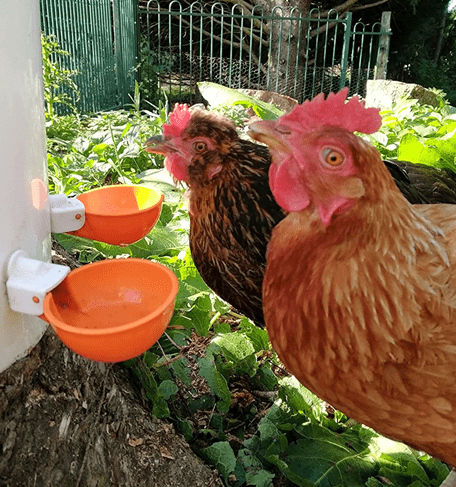Water - The Forgotten Nutrient
Adequate availability of water to birds is critical to bird health and performance. Water is sometimes referred to as the forgotten nutrient. It is considered one of the most important nutrients ingested and although it is inexpensive to provide, it is often the most neglected nutrient. Water makes up between 50 to 70% of a bird’s total body weight. An animal may lose 100% body fat and 50% body protein and live; however, a loss of 10% or more of body water will cause severe dehydration and may result in death.
Water consumed by the bird is required for a variety of physiological functions. Some of these include nutrient transportation, enzymatic and chemical reactions, regulation of body temperature, and lubrication of joints and organs. Exposure to high environmental temperatures is one factor that influences the water requirement of an animal because water is required to maintain body temperature. When birds are exposed to high temperatures they will pant as a means to lower their body temperature.
Water has a high heat of vaporization. Heat of vaporization is defined as the amount of energy required to transform a given quantity of a substance to a gas. The heat of vaporization of water is 540 calories (a form of energy) per one gram of water. This means that as one gram of water is converted to a vapor (evaporates), 540 calories are released as heat; therefore, lowering the bird’s body temperature.
The quality of your birds’ drinking water may also impact bird health and performance. Water should be free of pathogenic microorganisms and toxic levels of minerals and chemicals. If there is concern about your water’s safety for drinking, the water supply should be tested.
There is not a precise water requirement for poultry because water intake is related to numerous factors. Broilers consume approximately 1.6 to 2.0 times as much water on a weight basis as feed. There is a direct relationship between feed and water consumption. A study conducted by Lott and coworkers (2003) estimated the correlation between feed and water consumption at 0.98. A correlation of 0.98 means that when water consumption changes, 98% of the time feed consumption changes. Therefore, if you monitor daily water consumption, you can get a good idea of daily feed consumption. If there is a sudden change in water intake this may indicate a potential problem. A drop in water consumption may be the result of a clogged water filter or well pump problems, or it could indicate there are problems with a feed line motor or a possible bird health issue. There are many factors that may impact water consumption in poultry. See Table 1 to view several factors that affect water consumption.
How often should I water my birds?
Be sure to provide fresh, clean water daily to your birds. Often overlooked, water is not only one of the most important nutrients for animals but is often the least expensive too! Prevent water from becoming too hot or too cold because the birds will not drink it. Waterers should provide at least five to six gallons of water daily for every 100 birds (this will vary with very large or small species). Be sure enough waterers are available to provide one inch of watering room per bird. As recommended by Mississippi (2008), it is also important that waterers are cleaned three to four times a week in addition to being refilled daily with fresh water.
Similar to feeders, waterers should be placed so birds have easy access. Waterers are best placed in outside runs to reduce the level of humidity inside the coop. Feeder and drinker height should be placed at the height of the bird’s back (Clauer, 1998). Feeders and drinkers placed at this height will prevent waste and help keep feed and water clean. Allowing birds enough room to feed and preventing overcrowding will also prevent waste (Mississippi, 2008).
References:
Lott, B.D., W.A. Dozier, J.D. Simmons and W.B. Roush. 2003. Water flow rates in commercial broiler houses. Poultry Science 82 (Suppl. 1):102 [S56].
Files: Table 1
Feeds and Feeding: What are the Nutritional Needs of My Poultry?
Carbohydrates: Inexpensive Sources of Energy
Fats: A Concentrated Energy Source
Water - The "Forgotten Nutrient"
